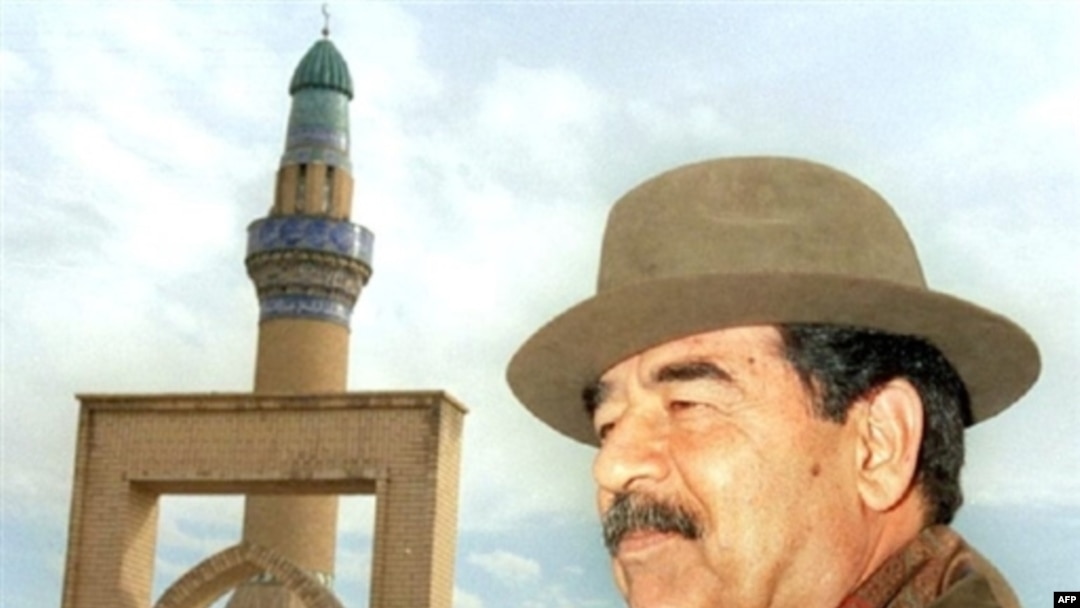The hanging of Hussein at dawn ends a life marked by war, bloodshed, and oppression. But it has not ended the suffering in Iraq, where many Iraqis are caught in a deadly insurgency that threatens to turn into a civil war.
Hussein was defiant when a special tribunal in the Iraqi capital sentenced him to death for crimes against humanity on November 5.
"Long live the people," Hussein said. "Long live the nation. Down with the agents. Down with the invaders. God is greatest; God is greatest; God is greatest; God is greatest; God is greatest; God is greatest."
That death sentence was carried out today inside Baghdad's Green Zone, with Hussein having styled himself a "sacrifice" for the country and calling on Iraqis to unite to face their enemies.
Hussein -- who was 69 years old -- ruled Iraq from 1979 until he fled the invading U.S.-led forces in early April 2003.
From Humble Beginnings...
Born to a shepherd family near Tikrit on April 28, 1937, Hussein had an unhappy childhood. Harshly treated by his stepfather, he ran away as a 10-year-old and went to live with his uncle in Baghdad.
There he took his first steps into political life, joining the Ba'ath Party in 1957 at age 20. This was a time of revolutionary fervor generated by the populist pan-Arabist president of Egypt, Gamal Abdel Nasser, and Hussein was deeply affected by it.
Hussein was involved in his first bloody political act in 1959, taking part in a failed bid to overthrow Iraqi Prime Minister Abd al-Karim Qassim, who himself had ousted Iraqi King Faisal II just one year earlier.
Hussein fled to Cairo to study law, but spent three years in a jail upon returning to Iraq. After that, Hussein rose steadily through the Ba'athist Party ranks to become Iraq's president in 1979. For several years before that, Hussein was in virtual control of the country, and is given credit for promoting advanced social programs, including equality for women, free compulsory education, and the best public health-care system in the Middle East.
...To Total Power
But his rule as president was marked by 24 years of increasing barbarity, as Hussein first led Iraq into a fruitless eight-year war with Iran in 1980 that resulted in an estimated 1.7 million deaths on both sides.
He then invaded Kuwait in 1990 -- an invasion that led to the first Gulf War in which U.S.-led forces liberated Kuwait by driving the Iraqis out.
Dissent within Iraq was always met by repression. In 1988, up to 5,000 Iraqi Kurds were killed and twice that number seriously injured when Iraqi forces used poison gas to attack the Kurdish town of Halabja.
In 1991, in the wake of the war with Iran, Hussein suppressed uprisings in the Kurdish north and Shi'ite southern and central parts of Iraq, with the reported loss of tens of thousands of lives.
Iraq's current national security adviser, Muwaffaq al-Rubay'i, expressed shock at Hussein's callousness when he visited him in prison in December 2003, the day after his capture.
"I came out of that meeting very angry -- very, very angry -- that he has absolutely no remorse towards the crimes he has committed against the Iraqi people," al-Rubay'i said. "The man is unrepentant. He is pure evil."
Hussein's high crimes were not only directed against humanity, but also against the environment. He set fire to the Kuwaiti oil wells, causing massive ground and air pollution, and he drained Iraq's great marshlands -- believed by some to be the location of the biblical Garden of Eden.
Showdown With The West
During the 1990s, with UN sanctions strangling an Iraqi economy already hit by the long war with Iran, Hussein hurtled defiance at the Western powers as intelligence reports suggested he was building weapons of mass destruction (WMD). UN inspectors searched for these alleged weapons, but said they did not receive enough cooperation from the Iraqis to be sure of anything.
In the atmosphere following the September 11, 2001, terrorist attacks in the United States, the allegations about WMD and Iraqi links to terrorism grew until U.S. President George W. Bush decided to lead an invasion of Iraq to forestall the use of these purported weapons.
Though neither WMD nor extensive Iraqi links with terrorist organizations were found, Hussein's days in power were numbered as the U.S.-led military intervention began on March 19, 2003.
"At this hour, American and coalition forces are in the early stages of military operations to disarm Iraq, to free its people, and to defend the world from grave danger," Bush told a U.S. television audience that night. "On my orders, coalition forces have begun striking selected targets of military importance to undermine Saddam Hussein's ability to wage war. These are the opening stages of what will be a broad and concerted campaign."
The Iraqi military crumbled quickly and Hussein was on the run after fleeing Baghdad. He was finally captured hiding in a hole in the ground near his hometown of Tikrit on December 13, 2003.
Hussein was married three times and had six children.


